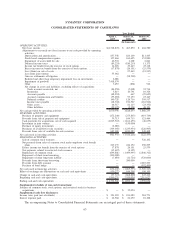Symantec 2009 Annual Report Download - page 128
Download and view the complete annual report
Please find page 128 of the 2009 Symantec annual report below. You can navigate through the pages in the report by either clicking on the pages listed below, or by using the keyword search tool below to find specific information within the annual report.
Inventories
Inventories are valued at the lower of cost or market. Cost is principally determined using the first-in, first-out
method. Inventory predominantly consists of finished goods as well as deferred costs of revenue. Deferred costs of
revenue were $24 million as of April 3, 2009 and $32 million as of March 28, 2008, of which $17 million and
$22 million, respectively, are related to consumer products that include content updates and will be recognized
ratably over the term of the subscription.
Property and Equipment
Property, equipment, and leasehold improvements are stated at cost, net of accumulated depreciation and
amortization. Depreciation and amortization is provided on a straight-line basis over the estimated useful lives of
the related assets. Buildings are depreciated over 25 to 30 years, and leasehold improvements are depreciated over
the lesser of the life of the improvement or the initial lease term. Computer hardware and software is depreciated
over two to five years and office furniture and equipment is depreciated over a three to five-year period. The
following table summarizes property and equipment by categories for the periods ending:
April 3,
2009
March 28,
2008
Year Ended
(In thousands)
Property and equipment, net:
Computer hardware and software ........................... $1,041,195 $ 925,156
Office furniture and equipment............................. 200,943 292,306
Buildings............................................. 483,105 492,857
Leasehold improvements ................................. 246,613 276,116
1,971,856 1,986,435
Less: accumulated depreciation and amortization.............. (1,077,034) (1,079,468)
894,822 906,967
Land ................................................ 78,452 94,783
Property and equipment, net: ............................ $ 973,274 $ 1,001,750
Business Combinations
We account for acquisitions using the purchase method of accounting under SFAS No. 141(R). Each acquired
company’s operating results are included in our consolidated financial statements starting on the date of acquisition.
The purchase price is allocated to tangible and identifiable intangible assets acquired and liabilities assumed as of
the date of acquisition. Goodwill is recognized for the remaining unallocated purchase price.
Amounts allocated to assets are based upon fair values. Such valuations require management to make
significant estimates and assumptions, especially with respect to intangible assets. Management makes estimates of
fair value based upon assumptions believed to be reasonable. These estimates are based on historical experience and
information obtained from the management of the acquired companies and are inherently uncertain. Other
separately identifiable intangible assets generally include acquired product rights, developed technology, customer
lists and tradenames. We did not acquire in-process research and development (“IPR&D”) in the fiscal years 2009,
2008 and 2007.
Amounts allocated to liabilities assumed are based upon present values of amounts to be paid determined at
current market rates. We estimate the fair value of deferred revenue related to product support assumed in
connection with acquisitions. The estimated fair value of deferred revenue is determined by estimating the costs
68
SYMANTEC CORPORATION
Notes to Consolidated Financial Statements — (Continued)
























